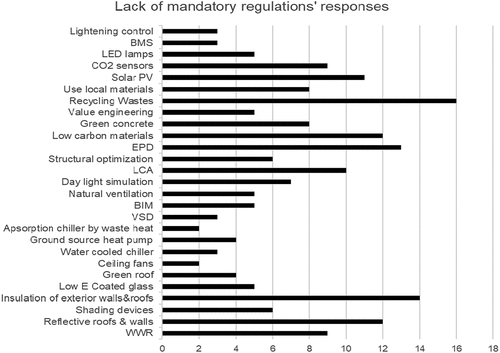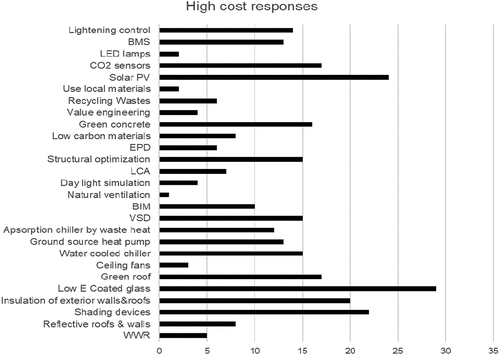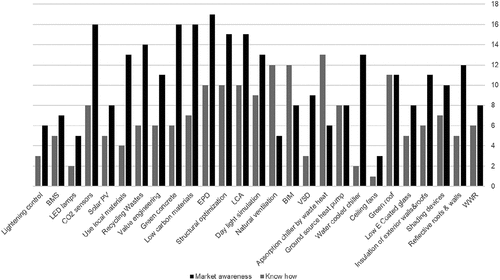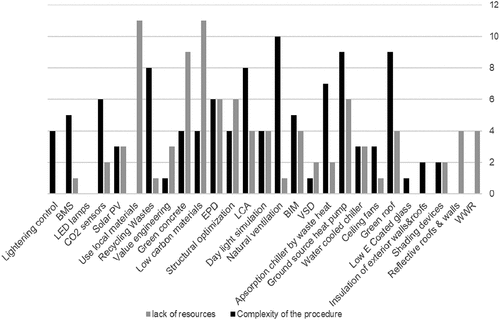ABSTRACT
The building sector significantly contributes to energy consumption and carbon emissions. Moving toward decarbonization practices becomes a strategic target. Although there are energy building codes and a green building rating system developed by the Egyptian government, they have not been widely implemented in the building sector due to different barriers. This paper investigates the gap between the theories of decarbonization principles and the adoption of these principles in practice in the Egyptian building sector. First, a semi-structured questionnaire was developed to identify the common barriers against successful implementation of decarbonization practices. The six identified barriers were lack of mandatory regulations, high cost of some decarbonization measures, client requirements, market awareness and knowledge, lack of resources, and complexity of some decarbonization procedures. Then, a questionnaire has been developed, including 25 decarbonization measures collected from GPRS (Green Pyramids Rating System), EDGE (Excellence Design for Greater Efficiency) and the regional roadmap for buildings and construction in Africa. The questionnaire has been distributed among experts to evaluate the availability of implementing these measures in the building sector against the identified barriers to identify a checklist for the most plausible measures applicable to the Egyptian building sector. Based on data analysis, eight decarbonization measures from the proposed measures have been proposed to be more appropriate to the Egyptian building sector. This paper will help researchers and practitioners identify the most appropriate decarbonization measures and strategies for the building sector.
Introduction
According to the last report about green building and sustainable construction in emerging markets developed by the International Finance Corporation (IFC), the CO2 emission from building operations represents 20.4%, while it represents 18.7% from the production of construction materials globally [Citation1]. In Africa in 2018, buildings accounted for 32% of process-related CO2 emissions and 61% of total final energy consumption. Buildings may reduce over 100 MtCO2 yearly emissions less than their current emissions according to sustainable development strategy (SDS) [Citation2]. By increasing energy efficiency, minimizing the use of materials and promoting the adoption of distributed low-carbon and renewable energy generation, decarbonization is crucial and will help the building sector to enrich the global economy [Citation3]. Governments can create frameworks for action in policy, technology, research, education, awareness-raising, and finance by agreeing to enforceable mitigation and decarbonization targets for the construction sector [Citation4].
Decarbonization means overcoming carbon lock-in to eliminate fossil fuel use and reduce greenhouse gas emissions to zero [Citation5]. Decarbonizing buildings has positive environmental effects that are crucial for reducing climate change and achieving the Paris Agreement’s global temperature goals. According to a previous study, adopting energy-efficient practices such as envelope, lighting, ventilation, air-conditioning (HVAC) system, and service water heating system in office buildings in Chile can reduce life cycle carbon emissions by up to 17% [Citation6]. Reusing existing buildings rather than building new ones, designing buildings to minimize their operational energy demand, designing spaces and structures efficiently, minimizing waste and reduction of embodied carbon (E.C) through design and at the manufacturing stage are the most recommended actions to decarbonize the real estate in the UK [Citation7].
Literature review
Several studies discussed the barriers against implementing sustainable and green building practices. The high initial cost, lack of policies and government standards, market awareness, and the long time required to recover capital invested are the common barriers that tackle the growth of green transformation globally and specifically in developing countries [Citation8–11]. To achieve a better understanding of best practices to decarbonize the building sector in Egypt, the key measures of adopting decarbonization practices and their impacts on the built environment, the challenges against implementing these practices and how to overcome them, and finally, which of them are eligible to be mandated in the building codes should be known.
According to previous studies and global building sustainability roadmaps, decarbonization procedures have two ways. The first is related to achieving energy efficiency through building operations, and the second is an E.C mitigation strategy at the material level [Citation1]. The design and structure of the building envelope influence 20% to 60% of all energy utilized in buildings [Citation12]. Choosing the appropriate materials for the building envelope will significantly reduce energy consumption and associated emissions during the building’s life cycle [Citation13]. Also, enhancing the building envelope, the appropriate color of external walls, suitable insulation, double-glazing windows, and solar shading can reduce cooling requirements by 30–50%. In addition, air conditioners with variable speed drive (VSD) components are very efficient [Citation14]. Several procedures have been developed in recent years to enhance the operational emissions of buildings without considering the harmful emissions from the building materials’ life cycle stages. According to a study to evaluate the whole life carbon of a building in the United Kingdom, it was found that the cradle-to-grave (A1–A3) stage of the life cycle is a major contributor toward the E.C of a building due to the extraction of raw materials, the transportation and manufacturing process of the building materials. It is responsible for 32% of carbon emissions, while the use stage (B1–B5) represents 20% of embodied carbon emissions [Citation15]. Efforts to enhance production techniques for conventional materials range from building fewer structures, using low-carbon materials, to implementing circular approaches. Such strategies may cut greenhouse gas emissions from residential building’ material cycle by more than 80% by 2050 [Citation16]. LCA faces some challenges which affect its accuracy such as manual data collection, complexity of building components and geographic variance. Combining the digital built environment representation of BIM with the thorough assessment of LCA could improve data sharing, update evaluations, and increase the precision and range of results [Citation17].
An SD (system dynamics) of building energy consumption and carbon emissions model is used to interact a system with the environment. It was developed to investigate the features of China’s residential structures’ energy use and carbon emissions, along with the associated emission reduction tactics. The results show that building energy usage is negatively inhibited by elements including electricity pricing, solar PV panel area, and energy-saving awareness. Home size, heat transfer coefficients from the roof and external walls, energy usage patterns, and home structure all have a positive driving effect on building energy consumption [Citation18].
According to the World Green Building Council, the movement in several European countries such as Finland, France, and the Netherlands will lead to legislative recognition of LCA standards for the building industry, and higher market penetration of EPDs (Environmental product declaration) is expected. Establishing guidelines and protocols for material testing will be essential. If there are building regulations in place, they ought to either set minimum environmental performance standards for the materials to be used or require the use of low-carbon products through performance criteria [Citation3].
Research objective
This study aims to investigate the gap between the theories of decarbonization principles and the adoption of these principles in the Egyptian building sector. It will provide a checklist of the most plausible practices that can be suggested as mandatory strategies for building energy efficiency code.
Research methodology
To identify the challenges against implementing the decarbonization strategies in practice in the building sector, the research methodology comprises two stages as follows: -
Part (1): - Semi-structured interviews were done over three months from February 2023 to the end of April 2023 with the stakeholders in the building sector by telephone, e-mail, and face-to-face to identify the barriers to adopt the decarbonization principles in the building sector.
Part (2): - A questionnaire survey was distributed among sustainability professionals, Green Certification experts, developers, decision-makers in public agencies, and contractors. The questionnaire includes the decarbonization technologies gathered from “Global ABC Regional Roadmap for Buildings and Construction in Africa (2020–2050)” [Citation2]. Two sustainability rating systems (EDGE and GPRS) were used to evaluate the validity and credibility of implementing these technologies in the Egyptian building sector. The barriers identified in part (1) will be used to validate the availability of adopting the proposed decarbonization technologies listed in part (2).
Data collection of the semi-structure interviews:
A semi-structured interview is a practical methodology for collecting qualitative data. It allows flexibility for the participants to introduce new ideas during the discussion [Citation10]. The experts were chosen based on their expertise in the field of sustainable design of the built environment. The questions were extracted based on the findings of the literature review about the challenges and barriers to sustainable practices implementation globally and in Egypt. The participants were asked to discuss the challenges against implementing sustainable designs and decarbonization measures in the building sector in Egypt. The interviews were performed with 14 participants through phone calls and LinkedIn messages. illustrates the number of participants and their work categories:
Table 1. Number of experts and their job titles.
Analysis of the results
The different points of view allowed authors to go deeply into real challenges that prevent sustainable and green building thinking in Egypt.
The participants identified the main six barriers as follows
Lack of mandatory regulations
According to the interview with a LEED consultant, the lack of measurement methods during the life cycle stages of a building and the absence of mandatory decarbonization strategies have been identified as two significant barriers in the building sector in Egypt.
[We can’t mitigate what we can’t measure. Methods of the energy consumptions and buildings’ carbon footprint measurements should be considered … also, there is an energy efficiency buildings code but it isn’t mandatory ….]
Another LEED consultant added that,
[The regulation in place sometimes over complicates the process such as, during the installation of solar photovoltaic panels (PV) …]
The high cost of many decarbonization practices
The high cost of embodied carbon mitigation procedures and the energy efficiency measures was a significant challenge that was highlighted by the participants.
[clients avoid using green concrete because its cost is higher than traditional concrete. Another challenge related to lack of green concrete suppliers in Egypt …]
[obtaining an EPD for a material costs the client much money, and it doesn’t mandatory in Egypt, as well as many energy efficiency procedures such as installation of E-Coated glass and shading devices …]
According to the interview with an EDGE expert, the change to energy-efficient technologies in a project depends on the client’s requirements, such as adopting a suitable window-to-wall ratio and using specified building materials.
Market awareness &knowledge
An EDGE expert added that lack of awareness of the new sustainable buildings’ technologies and the environmental impacts of building life cycle stages were essential challenges against achieving decarbonization goals. Additionally, the absence of clients’ awareness about the cost efficiency of decarbonization technologies in the long run makes the investment in green buildings risky.
Another comment is related to the lack of a qualified technical team in the sustainability field.
[clients miss the awareness of the payback period of green buildings as it actually achieves about 20% cost savings. … Unfortunately, people are looking only on the high initial cost]
[Although there is an increase in the LEED experts, lack of experience about LEED requirements particularly from consultants’ side slow the project progress, which negatively affect time and money]
Lack of resources
Also, sustainability experts added that lack of resources is a critical challenge that discourages the acceleration of decarbonization technology transition.
[In some projects, it is difficult to find the required types of insulation materials that could achieve better thermal performance of the building, types of bricks and faucets for water efficiency in the Egyptian market …]
Complexity of the procedures
A natural ventilation system and the installation of a ground heat pump are two energy efficiency measures mentioned as examples of complex procedures to be implemented in Egypt by two participants.
From previous findings, it is clear that significant barriers need to be examined before developing a decarbonization strategy for the building sector. Such examination would verify the proper implementation of the strategies that will assist in achieving buildings’ sustainability goals
The questionnaire survey
A Google form questionnaire including 25 decarbonization measures from GPRS, EDGE, and the Global ABC Regional Roadmap for Buildings and Construction in Africa (2020–2050) was distributed randomly. The survey aims to investigate the barriers against implementing the proposed decarbonization procedures from the three platforms. The collected procedures are classified according to the three main stages of the building life cycle: at the decarbonization measures for design, construction, and operational stages have been described as shown in . The respondents were invited to choose the barriers from the identified six barriers based on the semi-structured interviews for each proposed decarbonization procedure listed in . Only forty-three responses were collected; 58% of the responses were from
Table 2. The proposed decarbonization measures and their description.
consultants,18% were contractors, 11.6% were from academic institutions, 7% were from public agencies, and 4.7% were Developers. About 94.6% of the respondents are familiar with sustainable building design.
Analysis and discussion
The figures below describe the relation between the identified measures and the frequency of the responses for each measure.
Lack of mandatory regulations
Based on the collected results, the procedure that achieved 50% or more of responses in the identified barrier is considered highly needed and should be mandated in the government decarbonization strategy. As shown in , some measures have received a large number of responses related to the lack of regulations concerning (solar PV, recycling wastes, low carbon materials, EPD, LCA, insulation of external walls & roofs, and reflective walls and roofs.
High cost
shows that the second major barrier is the high cost of many energy efficiency measures, which received the most significant number of responses. So, the procedures that achieved less than 50% of responses are considered low-cost decarbonization measures that need a critical look to be proposed as possible and applicable procedures, which are natural ventilation, use of local materials, LED lamps, ceiling fans, value engineering, daylight simulation, recycling wastes, EPD, LCA, reflective roofs & walls, BIM and use low carbon materials. However, (solar PV, low E coated glass, shading devices, green concrete and CO2 sensors) are considered high-cost procedures according to the survey respondents. This reflects the strong perception of the client and contractor that implementing green practices is costly.
Client requirements
Due to the lack of proper understanding about the advantages of sustainable and decarbonization procedures from the client side and the unfamiliarity of buildings sustainability methods as mentioned by experts, indicates that five top measures have been subjected to client requirements, which are lightening control, use local materials, natural ventilation, ceiling fans, and window-to-wall ratio, in addition to their low initial cost and popularity in the building sector (according to )
Market awareness and knowledge
According to the interviews, the lack of experienced technical team and market awareness are considered significant challenges against the widespread of decarbonization principles in Egypt. illustrates that there are 12 international procedures had received 50% of the total responses which are related to market awareness barrier, which include (low carbon materials, shading devices, CO2 sensors, ground source heat pump, daylight simulation, EPD, LCA, structural optimization, natural ventilation, BIM, green roof and the absorption chiller by waste heat), while CO2 sensors, EPD, LCA, daylight simulation, natural ventilation, BIM, absorption chiller with waste heat and green roof are relatively not widespread due to technical knowledge limitations. That leads to the need to develop a national strategy that connects all stakeholders in the construction sector. It could help raise awareness of the decarbonization measures and the new sustainable building designs, creating an environmental inventory database of the building materials and developing more simplified tools to address the carbon emissions through the building life cycle
Lack of resources & complexity of the procedure
indicates that green roofs, ground source heat pump, natural ventilation, LCA, and recycling wastes are the major complex procedures to be performed in Egypt. Adopting a natural ventilation system has the largest number of responses due to the complexity of achieving comfort under different climate conditions of the year. EDGE has set many design criteria to facilitate the implementation of natural ventilation system in buildings and many energy efficiency measures, which could guide clients to more sustainable building design if they decide to get green building certification.
Additionally, lack of resources such as green concrete, local materials and low embodied building materials are common obstacles identified by the respondents, as shown in . This agrees with the results of the semi-structured interviews. The lack of green concrete and low embodied carbon material suppliers in Egypt may affect the carbon footprint mitigation strategy and increase the cost of implementing such procedures in projects.
Conclusion
This paper identified a checklist of the most eligible decarbonization measures for the building sector in Egypt. Based on data analysis, the cost of energy efficiency procedures is a critical barrier that discourages their implementation, such as low-E coated glass, PV solar panels, and shading devices. In addition, market awareness is a significant barrier against adopting E.C. reduction measures such as structural optimization, LCA, and EPD. So, the following decarbonization strategies have been proposed as the most applicable decarbonization measures for the building sector in Egypt:
Adopting a natural ventilation system taking into consideration the building orientation.
Using LED lamps and ceiling fans
Using smart models at the early stage of design such as BIM & daylight simulation.
Adopting reflective roofs & walls measure by using light colors for finishes
Recycle building material waste and developing waste management strategy on site.
Use local materials such as rammed earth, instead of importing other materials from other countries which increase the embodied carbon emissions due to transportation process.
Using low embodied carbon materials such as autoclaved aerated concrete for walls instead of red bricks and timber instead of steel for frames.
Applying LCA at the early stage of the design and developing EPD reports for building materials.
It is also recommended that low-cost energy efficiency procedures be mandated, and the market should be allowed to open up to new low-carbon materials such as green concrete and lightweight structures. In addition, developing an Egyptian building materials database would facilitate LCA application and pave the way to transitioning from a linear economy to a circular economy. Moreover, setting embodied carbon emissions and energy efficiency benchmarks for the building sector in Egypt would accelerate the sustainable development transition.
Research limitation
This research was carried out in Egypt to bridge the gap between decarbonization principles and their practical adoption in the Egyptian building sector.
Disclosure statement
No potential conflict of interest was reported by the author(s).
References
- Sustainable Construction in Emerging Markets Building Green Report. 2023. Available from: www.ifc.org;
- Energy Agency - United Nations Environment Programme, I. Global ABC Regional Roadmap for Buildings and Construction in Africa 2020-2050 Towards a Zero-Emission, Efficient, and Resilient Buildings and Construction Sector; 2020. n.d. https://www.iea.org/corrections
- Decarbonizing the Building Sector 10 Key Measures. Global Alliance for Buildings and Construction: United Nations Environment Programme (UNEP); 2021.
- Decarbonising UK real estate report. Royal Inistitution of Chartered Surveyors (RICS); 2022.
- Linton S, Clarke A, Tozer L. Strategies and governance for implementing deep decarbonization plans at the local level. Sustainability (Switzerland). 2021;13(1):1–22. doi: 10.3390/su13010154
- Ye Y, Dehwah AHA. Adjustment of Matrix Effects in Analysis of 36 Secondary Metabolites of Microbial and Plant Origin in Indoor Floor Dust Using Liquid Chromatography-Tandem Mass Spectrometry. Buildings. 2023;13(5). doi: 10.3390/buildings13041003
- Dadzie J, Runeson G, Ding G, et al. Barriers to Adoption of Sustainable Technologies for Energy-Efficient Building Upgrade—Semi-Structured Interviews. Buildings. 2018;8(4):57. doi: 10.3390/buildings8040057
- Mushi FV, Nguluma H, Kihila J. Factors influencing adoption of green buildings in Tanzania: a qualitative case study. Int J Building Pathology And Adaptation. 2023. doi: 10.1108/IJBPA-11-2022-0173
- Norouzi M, Haddad AN, Jiménez L, et al. Carbon footprint of low-energy buildings in the United Kingdom: Effects of mitigating technological pathways and decarbonization strategies. Sci Total Environ. 2023;882. doi: 10.1016/j.scitotenv.2023.163490 882.
- Lima MSS, Duarte S, Exenberger H, et al. Integrating BIM-LCA to Enhance Sustainability Assessments of Constructions. Sustainability. 2024;16(3):1172. doi: 10.3390/su16031172
- Ke Z, Hui Z, Jia X, et al. Research on energy efficiency and decarbonization pathway of nearly zero energy buildings based on system dynamic simulation. Developments In The Built Environ. ScienceDirect. doi: 10.1016/j.dibe.2023.100310
- Al-Yasiri Q, Szabó M. Incorporation of phase change materials into building envelope for thermal comfort and energy saving: a comprehensive analysis. In: Journal of Building Engineering. Vol. 36. Elsevier Ltd. p. 2023. doi: 10.1016/j.jobe.2020.102122
- Kulkarni SP, Karve S, Prajakta Kulkarni A, et al. Assessment of building envelope material for embodied energy to reduce global warming and ozone depletion potential. Int J Res And Analytical Rev. 2019;6(1):778–788.
- Bandyopadhyay B, Banerjee M. Decarbonization of cooling of buildings. Sol Compass. 2022;2:100025. doi: 10.1016/j.solcom.2022.100025
- Nyoman Suamir I, Nengah Ardita I, Made Rasta I. Effects of Cooling Tower Performance to Water Cooled Chiller Energy Use: A Case Study toward Energy Conservation of Office Building. In: Proceedings - 2018 International Conference on Applied Science and Technology, ICAST 2018. p. 712–717. doi: 10.1109/iCAST1.2018.8751530
- SCALinG tHE CiRCULAR BUiLt EnViRonMEnt Pathways for Business and Government 2 S C A L I N G T H E C I R C U L A R B U I LT E N V I R O N M E N T Pathways for Business and Government What Change Is Needed to Transition from Linear to Circular Business Models? How Can the Private and Public Sectors Create a Level Playing Field and Drive the Scaling of the Circular Built Environment? U I LT E N V I R O N M E N T Pathways for Business and Government. n.d.
- Abdelaal MA, Seif SM, El-Tafesh MM, et al. Sustainable assessment of concrete structures using BIM–LCA–AHP integrated approach. Environ, Devel And Sustainability;. 2023. doi: 10.1007/s10668-023-03701-3
- Hernández H, Ossio F, Silva M. Assessment of Sustainability and Efficiency Metrics in Modern Methods of Construction: A Case Study Using a Life Cycle Assessment Approach. Sustainability (Switz). 2023;15(7). doi: 10.3390/su15076267
- Saber HH, Hajiah AE, Maref W. Impact of reflective roofs on the overall energy savings of whole buildings. In: E3S Web of Conferences; 2020. p. 172. doi: 10.1051/e3sconf/202017225008
- Nutakki TUK, Kazim WU, Alamara K, et al. Experimental Investigation on Aging and Energy Savings Evaluation of High Solar Reflective Index (SRI) Paints: A Case Study on Residential Households in the GCC Region. Buildings. 2023;13(2):419. doi: 10.3390/buildings13020419
- Locke J, Dsilva J, Zarmukhambetova S. Decarbonization Strategies in the UAE Built Environment: an Evidence-Based Analysis Using COP26 and COP27 Recommendations. In: Sustainability (Switzerland). Vol. 15, Issue 15). Multidisciplinary Digital Publishing Institute (MDPI); 2023, (Vol. Doi: 10.3390/su151511603
- The Emergence of Cool Roofs. n.d. Available from: http://www.epa.gov/heatisland/resources/
- Wahba SM, Kamel BA, Nassar KM, et al. Effectiveness of Green Roofs and Green Walls on Energy Consumption and Indoor Comfort in Arid Climates. Civ Eng J. 2023;4(10):2284. doi: 10.28991/cej-03091158
- Nyoman Suamir I, Nengah Ardita I, Made Rasta I. Effects of Cooling Tower Performance to Water Cooled Chiller Energy Use: A Case Study toward Energy Conservation of Office Building. In: Proceedings - 2018 International Conference on Applied Science and Technology, ICAST 2018. p. 712–717. doi: 10.1109/iCAST1.2018.8751530
- Wang Z, Luther MB, Amirkhani M, et al. State of the art on heat pumps for residential buildings. Buildings. 2021;11(8). doi: 10.3390/buildings11080350
- Abdelaal MA, Seif SM, El-Tafesh MM, et al. Sustainable assessment of concrete structures using BIM–LCA–AHP integrated approach. Environ, Devel And Sustainability;. 2023. doi: 10.1007/s10668-023-03701-3
- Hernández H, Ossio F, Silva M. Assessment of Sustainability and Efficiency Metrics in Modern Methods of Construction: A Case Study Using a Life Cycle Assessment Approach. Sustainability (Switz). 2023;15(7). doi: 10.3390/su15076267
- Arellano-Vazquez DA, Moreschi L, Del Borghi A, et al. Use of EPD system for designing new building materials: the case study of a bio-based thermal insulation panel from the pineapple industry by-product. Sustainability (Switzerland); 2020. p. 12(17. doi: 10.3390/SU12176864





